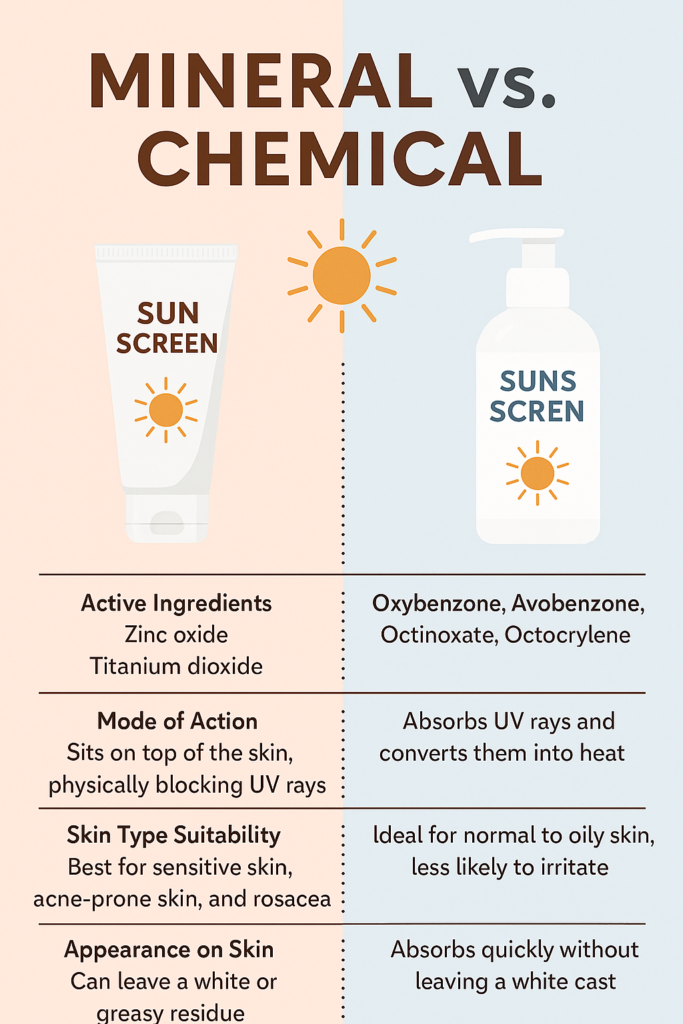When it comes to sun protection, sunscreen is an absolute essential. With numerous options available on the market, one of the most common debates revolves around mineral vs. chemical sunscreen. Both types serve the same purpose of protecting your skin from harmful UV rays, but they do so in different ways. Understanding the differences between these two types of sunscreen can help you make an informed decision about which one is better suited for your skin. In this blog, we’ll break down the benefits, downsides, and factors you should consider when choosing between mineral and chemical sunscreen.
What is Mineral Sunscreen?
Mineral sunscreen, also known as physical sunscreen, contains active mineral ingredients like zinc oxide and titanium dioxide. These minerals work by forming a physical barrier on the surface of the skin, reflecting and scattering UV rays away from the skin. Mineral sunscreens are often thicker and provide instant protection after application.
Key Features of Mineral Sunscreen:
- Contains zinc oxide and titanium dioxide as active ingredients.
- Physical barrier that sits on top of the skin.
- Broad-spectrum protection, covering both UVA and UVB rays.
- Often preferred for sensitive skin and skin conditions like rosacea or eczema.
What is Chemical Sunscreen?
Chemical sunscreen, also known as organic sunscreen, absorbs UV rays into the skin using active chemical ingredients such as oxybenzone, avobenzone, octinoxate, and octocrylene. Once absorbed, the sunscreen turns UV rays into heat, which is then released from the skin. Chemical sunscreens are often lighter in texture and may feel more comfortable on the skin for daily use.
Key Features of Chemical Sunscreen:
- Contains chemical ingredients like oxybenzone, avobenzone, and octinoxate.
- Absorbs UV rays and converts them into heat.
- Requires about 20 minutes to take effect after application.
- Lighter texture, making it ideal for those who dislike the heavier feel of mineral sunscreens.
Comparing Mineral vs. Chemical Sunscreen
To help you understand the differences between the two, let’s take a closer look at how mineral and chemical sunscreens stack up in various categories:
| Feature | Mineral Sunscreen | Chemical Sunscreen |
|---|---|---|
| Active Ingredients | Zinc oxide, Titanium dioxide | Oxybenzone, Avobenzone, Octinoxate, Octocrylene |
| Mode of Action | Sits on top of the skin, physically blocking UV rays | Absorbs UV rays and turns them into heat |
| Skin Type Suitability | Best for sensitive skin, acne-prone skin, and rosacea | Ideal for normal to oily skin, less likely to irritate |
| Appearance on Skin | Can leave a white or greasy residue | Absorbs quickly without leaving a white cast |
| Protection | Provides immediate protection after application | Takes about 20 minutes to take effect |
| Environment Impact | Reef-safe, less harmful to aquatic life | Can be harmful to coral reefs due to certain chemicals |
| Long-lasting | More durable under water and sweat-resistant | Needs reapplication more frequently, especially in water |
| Potential for Irritation | Less likely to cause irritation or allergic reactions | May cause irritation in sensitive skin or eyes |
Benefits of Mineral Sunscreen
- Gentle on Sensitive Skin: Mineral sunscreen is often recommended for people with sensitive skin, as it’s less likely to cause irritation compared to chemical sunscreens.
- Instant Protection: Mineral sunscreens offer immediate protection upon application, so you don’t need to wait before heading out into the sun.
- Reef-Safe: Many mineral sunscreens are considered reef-safe, meaning they don’t contain harmful chemicals that can damage coral reefs. This makes them an eco-friendly option.
- Non-Irritating: Zinc oxide and titanium dioxide are not absorbed into the skin, making them less likely to cause allergic reactions or irritation, especially for individuals with conditions like rosacea or eczema.
Benefits of Chemical Sunscreen
- Light Texture: Chemical sunscreens are generally thinner and feel lighter on the skin compared to the thicker texture of mineral sunscreens. This makes them a better option for those who don’t like the heavy, greasy feeling of physical sunscreen.
- Enhanced Cosmetic Elegance: Because chemical sunscreens don’t leave a white cast on the skin, they are often more suitable for daily use, especially for individuals with darker skin tones.
- Easier to Apply: With a lighter texture, chemical sunscreens can be easier to spread across the skin, making them ideal for people who are always on the go.
- More Variety: Chemical sunscreens typically come in a variety of formulas, such as sprays, gels, and lotions, offering more options for different preferences and needs.

Which Sunscreen is Right for You?
Both mineral and chemical sunscreens have their unique advantages, but the right one for you depends on your skin type, needs, and preferences. Here are some tips on choosing the right sunscreen:
- For Sensitive Skin: Opt for a mineral sunscreen, especially if you have conditions like acne, rosacea, or eczema.
- For Daily Use: If you prefer something light and easy to apply, a chemical sunscreen might be a better fit.
- For Active Lifestyles: If you need a sunscreen that is sweat and water-resistant, a mineral sunscreen may offer more durable protection.
- For Environmental Concerns: Choose mineral sunscreens that are labeled as reef-safe if you’re concerned about the impact of sunscreen on the environment.
Important FAQ About Mineral vs. Chemical Sunscreen
1. Can I use both mineral and chemical sunscreen? Yes, you can layer both types of sunscreen for maximum protection, but typically one type of sunscreen is enough to provide broad-spectrum coverage.
2. Are chemical sunscreens harmful to the skin? No, chemical sunscreens are generally safe for most people. However, those with sensitive skin or allergies to specific chemicals may experience irritation.
3. Which sunscreen is better for acne-prone skin? Mineral sunscreen is often better for acne-prone skin as it’s less likely to clog pores and irritate the skin.
4. Does mineral sunscreen leave a white cast? Yes, mineral sunscreen can leave a white cast, especially for those with darker skin tones. However, many modern formulas are designed to reduce this effect.
5. How often should I reapply sunscreen? Reapply sunscreen every two hours, or more often if swimming or sweating, regardless of whether you’re using mineral or chemical sunscreen.
6. Is one sunscreen better for the environment? Mineral sunscreens are typically more eco-friendly as they do not contain chemicals that harm marine life, particularly coral reefs.
In conclusion, mineral vs. chemical sunscreen is not a one-size-fits-all answer. Both types offer excellent protection from harmful UV rays, but the best choice for you depends on your specific needs. Whether you prefer the gentle nature of mineral sunscreens or the lightweight feel of chemical sunscreens, the most important factor is to ensure you apply sunscreen daily to protect your skin from sun damage.
For more information, check out our blog on healthyvibehub.com/blog!


